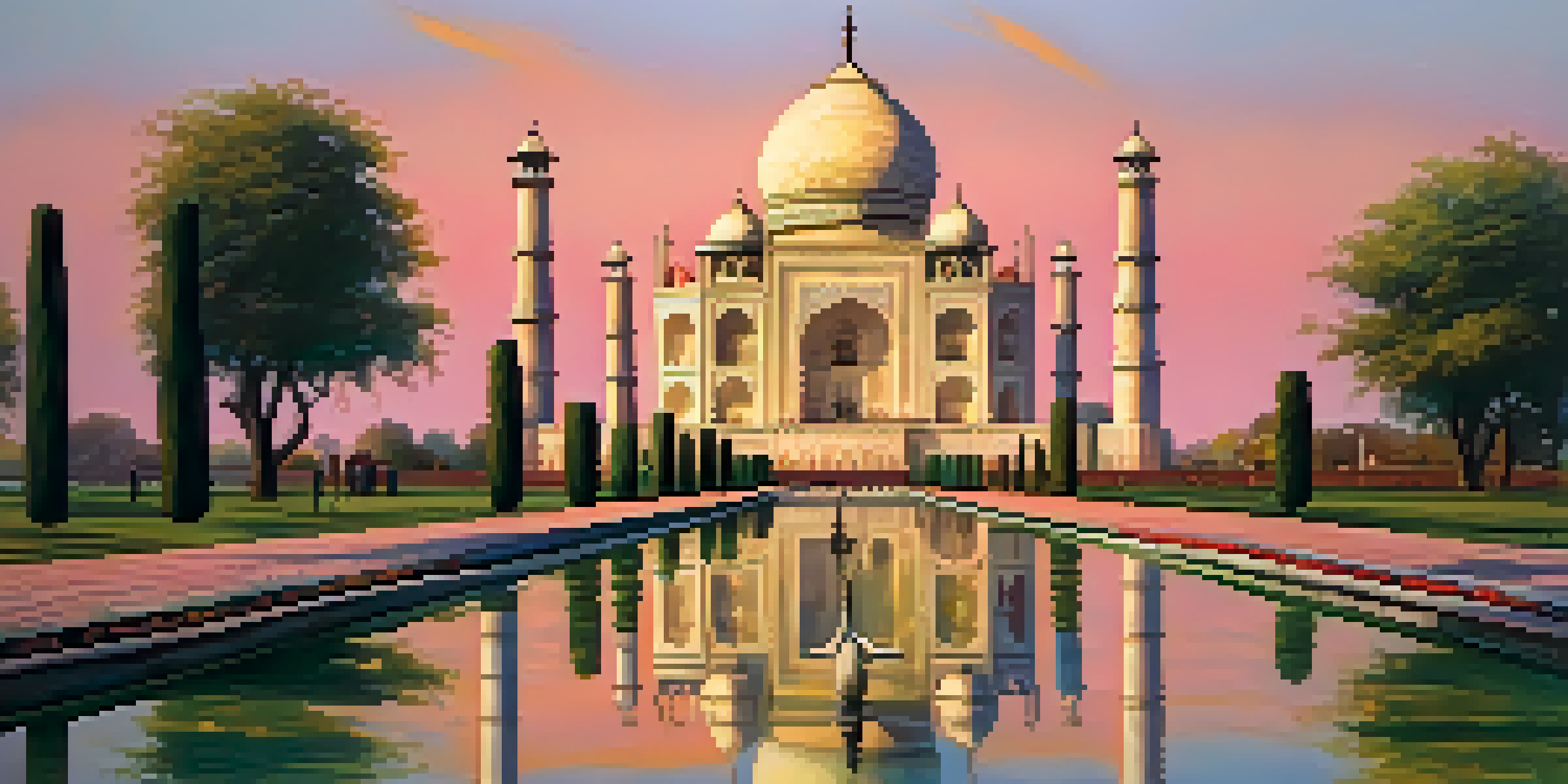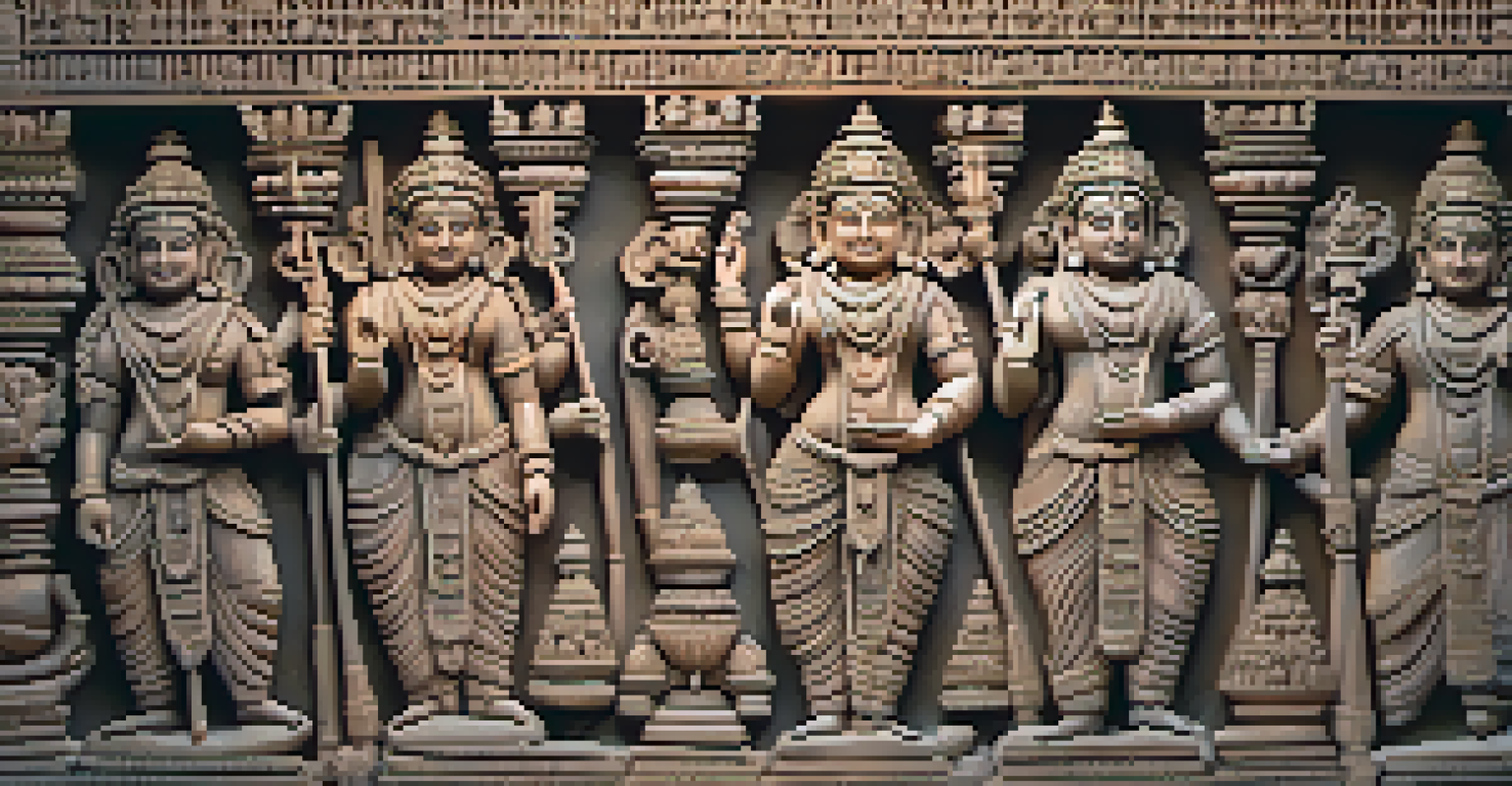Exploring India's Heritage Trails: A Journey Through History

Understanding the Significance of Heritage Trails in India
Heritage trails are more than just paths; they are the veins of culture running through the heart of India. Each trail narrates a unique story, showcasing the historical significance and rich traditions of the regions they traverse. They offer a chance to explore temples, forts, and monuments that have stood the test of time, providing invaluable insights into India's diverse heritage.
Heritage is our legacy from the past, what we live with today, and what we pass on to future generations.
Traveling along these trails allows visitors to connect with the past in a tangible way. Imagine walking through ancient ruins, feeling the cool stone under your fingers while absorbing the stories held within those walls. These experiences not only educate but also evoke a sense of belonging and appreciation for the collective history of the nation.
Whether you're an avid history buff or a casual traveler, heritage trails invite you to step back in time. They encourage exploration, curiosity, and a deeper understanding of the cultural tapestry that makes India so unique. By traversing these routes, you become part of a living history, enriching your own journey with each step.
The Golden Triangle: A Classic Heritage Route
The Golden Triangle, comprising Delhi, Agra, and Jaipur, is perhaps the most famous heritage trail in India. This route offers a perfect blend of architectural marvels and cultural experiences, with iconic sites like the Taj Mahal and Jaipur's Hawa Mahal. Each city has its own charm, presenting a different facet of India’s rich history.

As you explore Delhi, the capital city, you’ll encounter a mix of Mughal and British colonial architecture, from the grandeur of the Red Fort to the peaceful ambiance of Humayun's Tomb. In Agra, the Taj Mahal stands as a breathtaking testament to love and craftsmanship, drawing millions of visitors each year. Finally, Jaipur, the Pink City, enchants with its colorful bazaars and majestic forts.
Heritage Trails Showcase India's Culture
These trails allow travelers to connect with India's rich history through ancient sites and traditions.
Traveling along the Golden Triangle, you can also immerse yourself in local traditions, from savoring authentic cuisine to participating in vibrant festivals. This route is an ideal introduction to India's heritage, offering a glimpse into its past while celebrating its present.
Exploring the Temples of South India
South India is a treasure trove of ancient temples, each with its own unique architectural style and cultural significance. The intricate carvings and towering gopurams (temple towers) tell stories of gods and goddesses, drawing pilgrims and tourists alike. Places like Thanjavur and Madurai are renowned for their magnificent temples that showcase Dravidian architecture.
Traveling – it leaves you speechless, then turns you into a storyteller.
Visiting these temples is not just about admiring the structures; it's about experiencing the spirituality and rituals that have been practiced for centuries. For instance, the Brihadeeswarar Temple in Thanjavur is not only an architectural marvel but also a UNESCO World Heritage Site, where you can witness traditional ceremonies and local festivals.
As you wander through these sacred spaces, the atmosphere is often filled with the sounds of chanting and the fragrance of incense. This immersive experience allows you to appreciate the deep-rooted spiritual heritage of India, making it a meaningful journey for both the body and soul.
The Rich History of the Himalayan Trails
The Himalayan region offers stunning heritage trails that intertwine with breathtaking landscapes and rich cultural history. From the ancient monasteries of Ladakh to the charming villages of Himachal Pradesh, these trails provide a unique glimpse into the traditions of mountain communities. As you trek through these areas, you’ll discover a blend of nature and spirituality.
One of the most famous routes is the Markha Valley trek, which takes you through remote villages, lush valleys, and the breathtaking backdrop of the Himalayas. Here, you can visit Buddhist monasteries perched on cliffs, offering insight into the local culture and religious practices. Each step along the trail reveals stories of resilience and faith.
Golden Triangle: A Heritage Icon
The Golden Triangle of Delhi, Agra, and Jaipur offers a perfect blend of historical landmarks and cultural experiences.
Exploring these Himalayan trails is not just about the scenery; it’s about connecting with the locals, learning their customs, and enjoying their hospitality. The warmth of the mountain communities adds a personal touch to your journey, making every experience memorable.
The Historical Charm of Maharashtra's Forts
Maharashtra is home to numerous forts that stand as silent witnesses to the region's rich history and valor. These forts, such as Raigad and Sinhagad, are scattered across the Western Ghats, offering both historical significance and scenic views. Each fort has its own story, often linked to legendary figures like Chhatrapati Shivaji Maharaj.
Visiting these forts allows you to explore ancient architecture while enjoying stunning landscapes. The climb to the top of a fort often rewards you with panoramic views of the surrounding countryside, making the journey worthwhile. The remnants of old structures, cannons, and battle scars serve as reminders of the past.
Additionally, the local narratives and folklore associated with these forts enrich your understanding of Maharashtra's history. Engaging with guides or locals can provide fascinating insights, making your visit not just a trip but an enlightening experience filled with tales of bravery and heritage.
Cultural Trails of Rajasthan: A Feast for the Senses
Rajasthan, known for its vibrant culture and royal heritage, offers cultural trails that immerse you in its colorful traditions. From the majestic palaces of Udaipur to the bustling bazaars of Jaipur, each city showcases a unique aspect of Rajasthani life. These trails are a feast for the senses, offering sights, sounds, and flavors that linger long after your visit.
As you navigate through the streets adorned with traditional handicrafts, you can indulge in local cuisine bursting with spices and flavors. Don't miss the chance to try dishes like dal baati churma or gatte ki sabzi, which tell a story of culinary heritage passed down through generations. Festivals like Pushkar Mela add an extra layer of excitement to this cultural experience.
Preserving Heritage for Future Generations
Sustainable tourism and community involvement are essential for preserving India's heritage trails for years to come.
The hospitality of Rajasthani people enhances the charm of these trails, as they welcome visitors with open arms. Engaging with local artisans and attending cultural performances allows you to appreciate the deep-rooted traditions that define Rajasthan. This journey through Rajasthan's cultural trails is sure to leave you with cherished memories and a deeper understanding of Indian heritage.
The Legacy of the Silk Route in India
The Silk Route is not just a trade route; it’s a historical path that connects various cultures and civilizations. In India, parts of this ancient route traverse through places like Ladakh and Himachal Pradesh, showcasing a rich tapestry of interactions between traders, travelers, and local communities. Exploring these areas reveals how the Silk Route shaped the cultural landscape of India.
As you journey along these paths, you’ll encounter ancient caravanserais, monasteries, and relics of trade that speak to the vibrant exchanges that once took place. The historical significance of these sites is immense, offering a glimpse into the lives of those who traversed these challenging terrains in search of trade and knowledge.

Visiting these sites also allows you to appreciate the fusion of cultures that resulted from the Silk Route's influence. The blend of traditions, art, and cuisine reflects a legacy that continues to thrive, making this exploration not just a historical journey but a celebration of interconnectedness and diversity.
Preserving Heritage: The Future of India's Trails
As we explore India's heritage trails, it is crucial to consider the importance of preservation for future generations. Many of these sites face challenges such as environmental degradation, urbanization, and neglect. Sustainable tourism practices are essential to ensure that these treasures remain intact and accessible for years to come.
Community involvement plays a significant role in the preservation efforts. Local communities often act as guardians of their heritage, sharing knowledge and traditions while also benefiting economically from tourism. Supporting local initiatives can create a positive impact, helping to maintain the cultural integrity of these heritage sites.
Heritage Trails Showcase India’s Culture
Heritage trails in India offer a unique opportunity to explore historical sites and connect with the country’s rich cultural tapestry.
Looking ahead, there’s a growing awareness of the need to balance tourism with conservation. By promoting responsible travel and educating visitors about the importance of heritage, we can foster a deeper appreciation for India's historical treasures. Together, we can contribute to preserving these trails, ensuring they continue to inspire and educate future explorers.